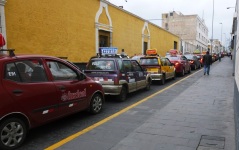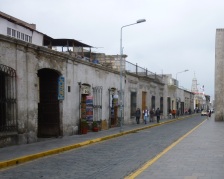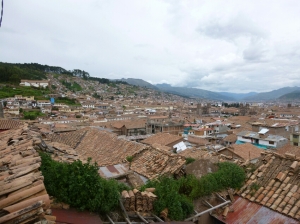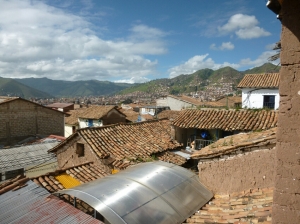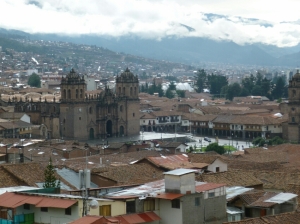 And lo they came down from the Andean mountains…to smog afflicted Lima, and didn’t see the sun for three days. For our Last Supper in Lima we thought we’d do something non-traditional, without a single figure of catholic idolatry in sight. So we nipped along to our fave vegan cafe in Magdalena del Mar – the excellent ‘Sinfonia vegana‘ on Jr Junin, 685 (website and FB) – for a couple of vegan pizzas. The ‘Espanola’ with the chorizo, and the ‘Campestre’ with seitan. Followed up with some luscious vegan cake, and washed down with a herbal infusion. Yum!
And lo they came down from the Andean mountains…to smog afflicted Lima, and didn’t see the sun for three days. For our Last Supper in Lima we thought we’d do something non-traditional, without a single figure of catholic idolatry in sight. So we nipped along to our fave vegan cafe in Magdalena del Mar – the excellent ‘Sinfonia vegana‘ on Jr Junin, 685 (website and FB) – for a couple of vegan pizzas. The ‘Espanola’ with the chorizo, and the ‘Campestre’ with seitan. Followed up with some luscious vegan cake, and washed down with a herbal infusion. Yum!
 We’ll shortly be leaving south America in peace and nipping back to our own ‘planet’ for a bit. But there’s still plenty of stories to tell and comments to be made on where we’ve been and what we’ve seen here, so the blogging will continue…here’s a few pieces lined up:
We’ll shortly be leaving south America in peace and nipping back to our own ‘planet’ for a bit. But there’s still plenty of stories to tell and comments to be made on where we’ve been and what we’ve seen here, so the blogging will continue…here’s a few pieces lined up:
– Is there true memory & justice in post-Pinochet Chile?
– The Valley of the Moon and human erosion (Bolivia)
– Chased down the Devil’s Molar by a storm (Bolivia)
– The Sea
– La Paz – the jewel in Bolivia’s communist crown?
– What truth and justice in Peru after Shining Path and state oppression?
– History and tragedy in Ayacucho (Peru)
– Six weeks in the navel of the world (Peru)
– So who the bloody hell were the Inca? (Peru)
– Will ayahuasca change the world? (Peru)
and maybe a few more…but if you are bored in the meantime check out our posts on Street Art in Bolivia and Chile. Salud!
Tag Archives: Lima
Back up the Andes – to Ayacucho for some Wari culture and post-civil war enquiry
 So enough of this mucking about at sea level and enjoying hot weather on beaches, it’s back up the mountains for a while for us. This time to the Ayacucho region in the south central Andes of Peru, an area steeped in Andean history for the last 2000 years, with a rebellious reputation that has endured. The history of the Wari (or Huari) culture intrigues because of its influence on the later ‘Inca empire’; the Battle of Ayacucho (1824) was a final stage of the war for Peru’s ‘independence’ from Spain; and for the last 20 years of the 20th century Ayacucho was at the centre of a bloody civil war that convulsed Peru and has repercussions to this day. Continue reading
So enough of this mucking about at sea level and enjoying hot weather on beaches, it’s back up the mountains for a while for us. This time to the Ayacucho region in the south central Andes of Peru, an area steeped in Andean history for the last 2000 years, with a rebellious reputation that has endured. The history of the Wari (or Huari) culture intrigues because of its influence on the later ‘Inca empire’; the Battle of Ayacucho (1824) was a final stage of the war for Peru’s ‘independence’ from Spain; and for the last 20 years of the 20th century Ayacucho was at the centre of a bloody civil war that convulsed Peru and has repercussions to this day. Continue reading
Back to Peru for some hummus, roll-ups and ancient fishing boats
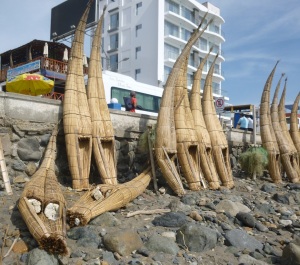 In early May we got out of Chile, and came back to Peru to check out some more pre-Inca history up on the north coast near Trujillo & Huanchaco – the Moche & Chimu cultures, and some sea going reed fishing boats, or rafts, called ‘caballitos de totora’ (or ‘de mar’), constructed using ancient craft skills dating back several thousand years and known only to a few. These boats are clearly linked to the Moche & Chimu cultures, and possibly earlier.
In early May we got out of Chile, and came back to Peru to check out some more pre-Inca history up on the north coast near Trujillo & Huanchaco – the Moche & Chimu cultures, and some sea going reed fishing boats, or rafts, called ‘caballitos de totora’ (or ‘de mar’), constructed using ancient craft skills dating back several thousand years and known only to a few. These boats are clearly linked to the Moche & Chimu cultures, and possibly earlier.
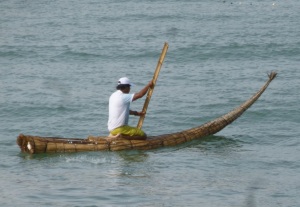 However they’ve moved with the times as you can see in the fotos, and now use polystyrene blocks to help float the boats, not something available in these parts two thousand years ago. Although the paddle or oar remains very basic, just a long bamboo pole cut in half lengthways. It looks hard work on the hands…but it seems to do the trick though as they negotiate their way out to sea through decent sized waves, and eventually back in again. The sea here looks and is cold, but the weather isn’t, even now in the autumn – a good 25 degrees minimum most days, and too hot on other days to even sit in the sun for long. Continue reading
However they’ve moved with the times as you can see in the fotos, and now use polystyrene blocks to help float the boats, not something available in these parts two thousand years ago. Although the paddle or oar remains very basic, just a long bamboo pole cut in half lengthways. It looks hard work on the hands…but it seems to do the trick though as they negotiate their way out to sea through decent sized waves, and eventually back in again. The sea here looks and is cold, but the weather isn’t, even now in the autumn – a good 25 degrees minimum most days, and too hot on other days to even sit in the sun for long. Continue reading
Taxi jams, black carbon, melting ice caps and climate change in Peru
Take a walk down a busy street in any of Peru’s larger towns & cities and the problem soon hits you – in the back of the throat, up the nose, in the eyes. It’s the choking stench of black cardon, fine particles like soot, pumped out of the exhuasts of Peru’s many older diesel combi-collectivos (small busses, people carriers, minibuses), taxis & lorrys of various sizes. It blackens the streets & buildings, causes serious health problems for the people, and contributes to climate change (read – the effects of black carbon).
Climate change – the causes of it and the problems it excaberates – is a real time problem in Peru and across Latin America. The 33 Latin American & Caribbean leaders meeting as the Community of Latin American & Caribbean States (CELAC, founded in 2010 – report here) in the Dominican Republic since Saturday, may well be looking nervously north to the Trump fantasist & bully, but they should also be looking closer to home before man-made & natural disasters sink their economies for good.
This late-2014 report ‘Dumping Dirty Diesels in Latin America: Reducing Black Carbon and Air Pollution from Diesel Engines in Latin American Countries’ (opens as a 48page pdf), written for the US based Natural Resources Defense Council (about NRDC), sets out in detail the short to long term impacts on public health & the environment, and provides a wealth of frightening statistics. It also calls for & suggests available solutions. Sadly, history indicates that the vast majority of the ruling elites (and their corporate buddies) of CELAC are unlikely to give a damn about anything except amassing their own power & fortunes, and will never commit to the necessary infrastructure and changes, never mind the funds required, to turn back climate change. Continue reading
#potd: In Peru the ‘Playa’ is not always the beach
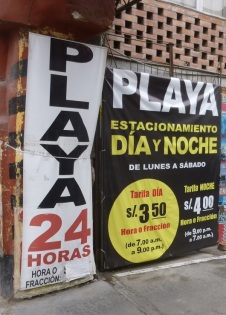
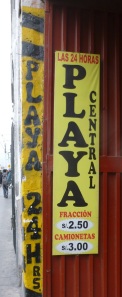 Here in Arequipa, in Peru, we find plenty of signs for the ‘playa’, which seems unlikely given we are some 2400m above sea level, with no sea in sight. In fact the many ‘playa’ signs signify the entrance to a car park, or ‘estacionamiento’, payable by the hour or part thereof. Costs vary from S/.3 to S/.5 per hour, depending on the centrality of the car park. Car parks offer security for the car, which is a big issue here where the theft of parts (if not the whole car) seems to be a big issue.
Here in Arequipa, in Peru, we find plenty of signs for the ‘playa’, which seems unlikely given we are some 2400m above sea level, with no sea in sight. In fact the many ‘playa’ signs signify the entrance to a car park, or ‘estacionamiento’, payable by the hour or part thereof. Costs vary from S/.3 to S/.5 per hour, depending on the centrality of the car park. Car parks offer security for the car, which is a big issue here where the theft of parts (if not the whole car) seems to be a big issue.
This isn’t the first time we’ve seen such signs. We saw them in Lima, Peru’s capital city, which even more confusingly also has ‘playas’ in the more traditional sense – being a coastal city it does have beaches, although the ones closest to the city are man-mad (at the foot of cliffs) and hard to access. Continue reading
Mass protest shuts Pan American Highway for 11 hours near Lima
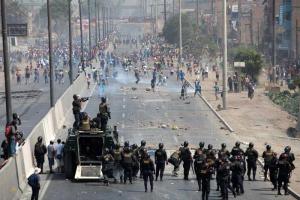 The PanAmericana Norte, the northern half of Peru’s section of the Pan-American Highway, was shutdown on Thursday from 7am to 8pm by protesters opposed to new toll booths some 27km north of Lima centre, in the district of Puente Piedra. See great photos & text (in Spanish); good Al Jazeera vid; Ruptly video; timeline of events + pics + vid (in Spanish). This road is the major north-south coastal road in/out of Lima and along the entire Peruvian coastline!
The PanAmericana Norte, the northern half of Peru’s section of the Pan-American Highway, was shutdown on Thursday from 7am to 8pm by protesters opposed to new toll booths some 27km north of Lima centre, in the district of Puente Piedra. See great photos & text (in Spanish); good Al Jazeera vid; Ruptly video; timeline of events + pics + vid (in Spanish). This road is the major north-south coastal road in/out of Lima and along the entire Peruvian coastline!
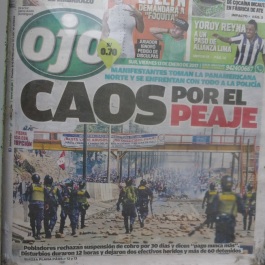 This was the second successive Thursday protest (5 January report in English), although people from nearby neighbourhoods have been protesting since last August. In fact it had been announced late on Wednesday that the toll would be suspended for 30 days, but this didn’t calm the peoples anger. Yesterday’s protest was led by the Mayor of Puente Piedra, and initially marchers shut down the north to south side of the Highway. Matters escalated with both sides of the Highway closed around 27km north of Lima centre, with police firing teargas & rubber bullets and baton charging protesters, who responded with rocks etc and barricaded parts of the Highway, trashing infrastructure & some bridges. Peruvian news coverage has been wide & mixed, generally condemning ‘violent’ protests whilst conceding the protesters have a point! Typical.
This was the second successive Thursday protest (5 January report in English), although people from nearby neighbourhoods have been protesting since last August. In fact it had been announced late on Wednesday that the toll would be suspended for 30 days, but this didn’t calm the peoples anger. Yesterday’s protest was led by the Mayor of Puente Piedra, and initially marchers shut down the north to south side of the Highway. Matters escalated with both sides of the Highway closed around 27km north of Lima centre, with police firing teargas & rubber bullets and baton charging protesters, who responded with rocks etc and barricaded parts of the Highway, trashing infrastructure & some bridges. Peruvian news coverage has been wide & mixed, generally condemning ‘violent’ protests whilst conceding the protesters have a point! Typical.
Continue reading
#potd: Indefinite strike in Peru’s Poder Judicial
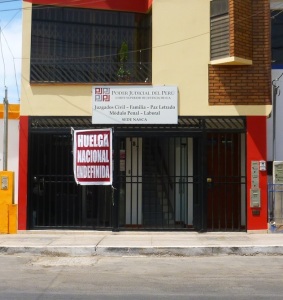 In the four places we’ve been to so far in Peru, we’ve seen the slogan ‘Huelga Nacional Indefinida’ hanging on the bars at the entrances to various of Peru’s courts. On the 22 November in Lima, we saw a street protest on the first day of the strike, that was swamped by riot police when it marched towards Peru’s Congress. Police had also sealed off roads around Lima’s Plaza Mayor in case strikers headed there.
In the four places we’ve been to so far in Peru, we’ve seen the slogan ‘Huelga Nacional Indefinida’ hanging on the bars at the entrances to various of Peru’s courts. On the 22 November in Lima, we saw a street protest on the first day of the strike, that was swamped by riot police when it marched towards Peru’s Congress. Police had also sealed off roads around Lima’s Plaza Mayor in case strikers headed there.
The Poder Judicial del Peru is a part of the government structures, and was first set up in 1825 to manage Peru’s court systems and ensure equality for all before the law (a laughable claim in Peru!). The strikers are employees of the Poder Judicial, and members of the FNTPJP union, the cause of this strike is for better pay & conditions, and because of previous broken promises. It has attractyed significant media interest, especially in Lima.
Info on the Poder Judicial in english & spanish.Background to strike in spanish.
Report on 28 November, largest strikers march to date, in central Lima in spanish.
Seven days in Lima, Peru
Gallery

This gallery contains 18 photos.
Our first week in South America, in Lima the capital of Peru, is over, and fascinating & challenging it was too! Lima is enormous, think of London and double the size & population; then quadruple the noise & traffic congestion … Continue reading
Into Lima, Peru – with Obama, Putin, Duterte and the gang
So we made it into Lima, Peru in the very very early hours of Saturday 19 November, just a couple hours after Obama, and a wee bit before Putin. The rest of their gang was already here – that’s the Asian Pacific Economic Community/Co-Operation (APEC2016 website), 21 countries bringing freedom, human rights & sustainability via, yes you guessed it, globalisation & free trade.
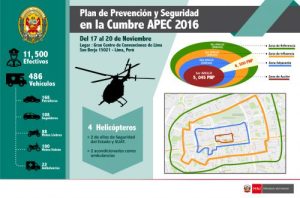 This event seems to have been virtually ignored beforehand by west European media, the BBC international website for example only mentioned Lima in days before the event in the context of a huge fire with fatalities at the seafront shopping mall & complex at LarcoMar, in the middle class & touristic area of Miraflores. Continue reading
This event seems to have been virtually ignored beforehand by west European media, the BBC international website for example only mentioned Lima in days before the event in the context of a huge fire with fatalities at the seafront shopping mall & complex at LarcoMar, in the middle class & touristic area of Miraflores. Continue reading
Hello Cusco! Hello Incas!
We made it to Cusco, 3300m up in the Peruvian Andes! This former capital of the Inca empire, and location of some extreme barbarity by the ‘Christian’ Spanish invaders throughout the mid-16th cenutry, sits at the centre of the ‘Sacred Valley’ tourist industry, and is a transit point for many visitors. It is a city steeped in history, that some claim goes back to 5000BC, way before the Incas emerged. Its history is both fascinating and controversial. Its location is absolutely stunning.
We arrived here by cama-coach on Saturday 22 February around midday, some 22hours after leaving Lima. We were not in great shape at all! Our journey from Lima had taken us south further along the Peruvian ‘desert coast’, before turning inland at Nasca. By then it was late evening as we drove towards the foothills of the Andes, we could see nothing out the coach window, and a long uncomfortable night awaited us.
Unlike Wednesday night when we were on the fairly straight and flat PanAmerican highway, the road up into the Andes twisted and turned and climbed constantly. As we were moved about in our cama-seats, sleep became a luxury we couldn’t enjoy. And not until about 5.30am could we see a damn thing in the black night, just the lights of other (large) vehicles rushing suddenly past. No wonder the sick-bags had been handed out before lights-out!
Daylight brought some relief, although a fag-stop would have been nice too! The stunning countryside passed us by as we continued the slow climb around valleys and over passes. We passed small indigenous communities, saw agriculture on steep hillsides, and watched rivers rushing by below us…and really hoped we wouldn’t end up in one. At times snow-covered mountain tops peeked through the clouds, and shards of bright sunlight breached the clouds. Awesome.
Rounding another mountain bend we saw Cusco, relief was near at last. On arrival we had a quick smoke in the high altitude air (yeah we know, not sensible!), jumped in a cab, and headed for our hostel. Our reservation here, arranged by phone from Guayaquil by our faraway family member, worked a treat, and the hostel owners are lovely – their son even speaks some English.
Our hostel is in the Santa Anna district of Cusco, about 15minutes walk gently uphill from the main square, and just outside the main tourist area. Its great, we’ll tell you more about it later. The pics here, views out over Cusco, are all taken from the back of our hostel on the second floor. The last pic shows the main square ‘Plaza de Armas’ with its inevitable dominating church.

